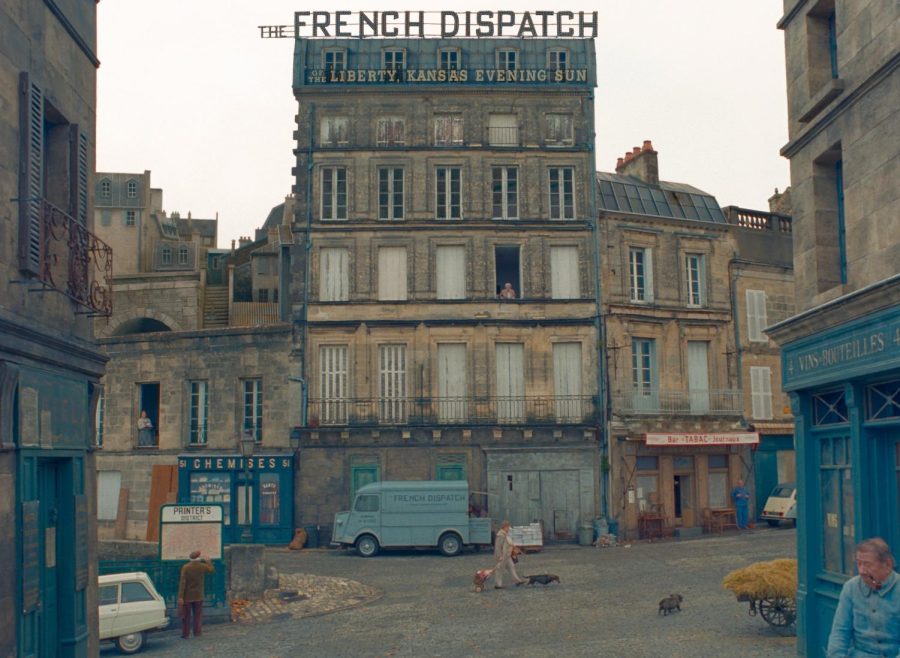‘The French Dispatch’ an Enchanting Love Letter to Art and The New Yorker
November 17, 2021
Wes Anderson has one of the most distinctive styles, both visually and musically, of any director working at this time. From the design of rooms to the clothes that the characters wear to the music that they listen to, the symmetry of the shot composition to the color palette, Anderson’s fingerprint is precise and easy to recognize.
As such, Anderson is rather like cilantro. You either have the gene for the taste or not. A certain person could look at a frame from an Anderson movie and find it enchanting and beautiful, while another could look at the very same frame and find it twee and precious. Both are firmly convinced of their rightness. The reasons that people love and hate Anderson are exactly the same.
For such a stylist, Anderson is also a remarkably literary filmmaker. His latest film, “The French Dispatch” is a love letter to the written word. The French Dispatch was originally the outpost of a small-town newspaper, the Liberty, Kansas’ Evening Sun. The publication is based in the fictional Ennui-Sur-Blasé, France, and overseen by a lovable crank of an editor Arthur Howitzer Jr. (Bill Murray). It is The New Yorker in all but name and location.
Like Reading a Magazine
An anthology film, “The French Dispatch” adapts the structure of a magazine issue, recounting long-form articles and columns from the final edition of the publication. It begins with the obituary of the recently deceased Howitzer, who stipulated that the newspaper would end with his death, coating the movie with a wistful, memory-play like nostalgia. It’s the end of an era, and Anderson will show you what is being lost.
After that, it goes into a local color column written by Herbsaint Sazerac (terrific name) played by Owen Wilson, who rides a bicycle around Ennui-Sur-Blasé with the aplomb of a silent film comedian.
Then there is “The Concrete Masterpiece,” with art critic J.K. L. Berensen (Tilda Swinton) flamboyantly telling the story of an imprisoned murderer (Benicio del Toro) whose abstract paintings are sensationalized by a scheming art dealer (Adrien Brody).
“Revisions to a Manifesto” is an account of the French Protests of May 1968, reported by correspondent Lucinda Krementz (Frances McDormand) through the eyes of student leader Zeffirelli (Timothée Chalamet).
The last feature, “The Private Dining Room of the Police Commissioner” finds a James Baldwin-like food critic Roebuck Wright (Jeffrey Wright) recounting on a Dick Cavett-type talk show how a simple profile of a celebrated chef got him mixed up in a kidnapping.
In small but fascinating ways, Anderson uses the language of cinema to replicate the act of reading a magazine. Oftentimes narration in a movie is distracting and redundant, but in “The French Dispatch” it serves a function. There are little shifts in the rhythm and style of each of the sections, illustrating that they were authored by different writers. Alexandre Desplat’s delightful, playful score mimics the clattering of typewriter keys or scratching of a pencil at times.
A Delightful and Charming Plea for the Importance of Art
It would take many viewings and a library-length bibliography to uncover all of the literary and pop culture references included in the movie, but while watching “The French Dispatch” it never feels as though anything is going over your head. One does not have to know that “The Concrete Masterpiece” was inspired by The New Yorker’s six-part piece on Art Dealer Lord Duveen, or catch the references to the movies of Jean-Luc Godard in “Revisions to a Manifesto.”
Anderson has a light and playful touch that moves through the vignettes with ease. It’s not pretentious. “The French Dispatch” is an easy watch with a gentle, dry sense of humor.
“The French Dispatch” is bursting with members of Anderson’s traveling acting troupe such as Murray, Brody, Wilson, Swinton, Edward Norton, Jason Schwartzman, Bob Balaban, Willem Dafoe and Anjelica Huston, but the best performance in the movie came from Wright. Even when landing jokes, his baritone voice brings to the surface the melancholy that has always lurked underneath Anderson’s tchotchkes and dioramas. His explanation for why he writes about food is breathtakingly poignant and gives “The French Dispatch” a rich, emotional importance.
Melancholy nips on the outskirts of ‘The French Dispatch,” disproving the detractors that seek to write Anderson off as a dollhouse maker. Writing about the movie, many critics have referred to it as an elegy, but I see it as a plea: a plea from Anderson for the preservation of beauty and art, and him trying to show the audience what that brings to life.








